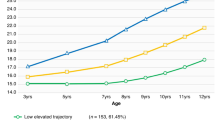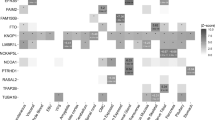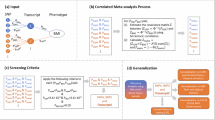Abstract
Body mass index (BMI) is used as a measure of fatness. Here we performed a genome-wide scan for genes related to BMI, while allowing for the possible effects of imprinting. We applied a sib pair linkage analysis to a sample of primarily children and young adults by using the Haseman–Elston method, which we modified to model the separate effects of paternally and maternally derived genetic factors. After stratification of sib pairs according to age, a number of regions showing linkage with BMI were identified. Most linkage and imprinting effects were found in children 5–11 years of age. Strongest evidences for linkage in children were found on chromosome 20 at 20p11.2-pter near the marker D20S851 (LODTotal=4.08, P=0.000046) and near the marker D20S482 (LODTotal =3.55, P=0.00016), and Chromosome 16 at 16p13 near the marker ATA41E04 (LODTotal =3.12, P=0.00025), and those loci did not show significant evidence for imprinting. Six regions showing evidence of imprinting were 3p23–p24 (paternal expression), 4q31.1–q32 (maternal expression), 10p14–q11 (paternal expression), and 12p12-pter (paternal expression) in children, and 4q31-qter (paternal expression) and 8p (paternal expression) in adults.
Similar content being viewed by others
Log in or create a free account to read this content
Gain free access to this article, as well as selected content from this journal and more on nature.com
or
References
Field AE, Coakley EH, Must A et al: Impact of overweight on the risk of developing common chronic diseases during a 10-year period. Arch Intern Med 2001; 161: 1581–1586.
Horwich TB, Fonarow GC, Hamilton MA, MacLellan WR, Woo MA, Tillisch JH : The relationship between obesity and mortality in patients with heart failure. J Am Coll Cardiol 2001; 38: 789–795.
Froguel P, Boutin P : Genetics of pathways regulating body weight in the development of obesity in humans. Exp Biol Med 2001; 226: 991–996.
Comuzzie AG, Williams JT, Martin LJ, Blangero J : Searching for genes underlying normal variation in human adiposity. J Mol Med 2001; 79: 57–70.
Rankinen T, Perusse L, Weisnagel SJ, Snyder EE, Chagnon YC, Bouchard C : The human obesity gene map: the 2001 update. Obes Res 2002; 10: 196–243.
Tilghman SM : The sins of the fathers and mothers: genomic imprinting in mammalian development. Cell 1999; 96: 185–193.
Bartolomei MS, Tilghman SM : Genomic imprinting in mammals. Annu Rev Genet 1997; 31: 493–525.
Falls JG, Pulford DJ, Wylie AA, Jirtle RL : Genomic imprinting: implications for human disease. Am J Pathol 1999; 154: 635–647.
Le Stunff C, Fallin D, Bougneres P : Paternal transmission of the very common class I INS VNTR alleles predisposes to childhood obesity. Nat Genet 2001; 29: 96–99.
Hayward BE, Moran V, Strain L, Bonthron DT : Bidirectional imprinting of a single gene: GNAS1 encodes maternally, paternally, and biallelically derived proteins. Proc Natl Acad Sci USA 1998; 22: 15475–15480.
Shore EM, Ahn J, Jan de Beur S et al: Paternally inherited inactivating mutations of the GNAS1 gene in progressive osseous heteroplasia. N Engl J Med 2002; 346: 99–106.
Moore T, Haig D : Genomic imprinting in mammalian development: a parental tug-of-war. Trends Genet 1991; 7: 45–49.
Hanson RL, Kobes S, Lindsay RS, Knowler WC : Assessment of parent-of-origin effects in linkage analysis of quantitative traits. Am J Hum Genet 2001; 68: 951–962.
Shete S, Amos CI : Testing for genetic linkage in families by variance components approach in the presence of genomic imprinting. Am J Hum Genet. 2002; 70: 751–757.
Lindsay RS, Kobes S, Knowler WC, Bennett PH, Hanson RL : Genome-wide linkage analysis assessing parent-of-origin effects in the inheritance of type 2 diabetes and BMI in Pima Indians. Diabetes 2001; 50: 2850–2857.
Lindsay RS, Kobes S, Knowler WC, Hanson RL : Genome-wide linkage analysis assessing parent-of-origin effects in the inheritance of birth weight. Hum Genet 2002; 110: 503–509.
Turner ST, Weidman WH, Michels VV et al: Distribution of sodium–lithium countertransport and blood pressure in Caucasians five to eighty-nine years of age. Hypertension 1989; 13: 378–391.
De Andrade M, Krushkal J, Yu L, Zhu D, Amos CI : ACT – A computer package for analysis of complex traits. Am J Hum Genet 1998; 63: A287 (abstract).
Haseman JK, Elston RC : The investigation of linkage between a quantitative trait and a marker locus. Behav Genet 1972; 2: 3–19.
Allison DB, Neale MC, Zannolli R, Schork NJ, Amos CI, Blangero J : Testing the robustness of the likelihood-ratio test in a variance-component quantitative-trait loci-mapping procedure. Am J Hum Genet 1999; 65: 531–544.
Terwilliger J, Ott J : Handbook of human genetic linkage. Baltimore: Johns Hopkins University Press, 1994.
Fulker DW, Cardon LR : A sib-pair approach to interval mapping of quantitative trait loci. Am J Hum Genet 1994; 54: 1092–1103.
Guo SW, Thompson EA : Performing the exact test of Hardy-Weinberg proportion for multiple alleles. Biometrics 1992; 48: 361–372.
Wilson AF, Elston RC, Tran LD, Siervogel RM : Use of the robust sib-pair method to screen for single-locus, multiple-locus, and pleiotropic effects: application to traits related to hypertension. Am J Hum Genet 1991; 48: 862–872.
Fernandez-Real JM, Vendrell J, Ricart W et al: Polymorphism of the tumor necrosis factor-alpha receptor 2 gene is associated with obesity, leptin levels, and insulin resistance in young subjects and diet-treated type 2 diabetic patients. Diabetes Care 2000; 23: 831–837.
Mitchell BD, Cole SA, Comuzzie AG et al: A quantitative trait locus influencing BMI maps to the region of the beta-3 adrenergic receptor. Diabetes 1999; 48: 1863–1867.
Hanson RL, Ehm MG, Pettitt DJ et al: An autosomal genomic scan for loci linked to type II diabetes mellitus and body-mass index in Pima Indians. Am J Hum Genet 1998; 63: 1130–1138.
Watanabe RM, Ghosh S, Langefeld CD et al: The Finland–United States investigation of non-insulin-dependent diabetes mellitus genetics (FUSION) study. II. An autosomal genome scan for diabetes-related quantitative-trait loci. Am J Hum Genet 2000; 67: 1186–1200.
Ohman M, Oksanen L, Kaprio J et al: Genome-wide scan of obesity in Finnish sibpairs reveals linkage to chromosome Xq24. J Clin Endocrinol Metab 2000; 85: 3183–3190.
Permutt MA, Wasson JC, Suarez BK et al: A genome scan for type 2 diabetes susceptibility loci in a genetically isolated population. Diabetes 2001; 50: 681–685.
Hsueh WC, Mitchell BD, Schneider JL et al: Genome-wide scan of obesity in the Old Order Amish. J Clin Endocrinol Metab 2001; 86: 199–1205.
Van der Kallen CJ, Cantor RM, van Greevenbroek MM et al: Genome scan for adiposity in Dutch dyslipidemic families reveals novel quantitative trait loci for leptin, body mass index and soluble tumor necrosis factor receptor superfamily 1A. Int J Obes Relat Metab Disord 2000; 24: 1381–1391.
Wu X, Cooper RS, Borecki I et al: A combined analysis of genomewide linkage scans for body mass index from the National Heart, Lung, and Blood Institute Family Blood Pressure Program. Am J Hum Genet 2002; 70: 1247–1256.
Rao DC, Gu C : False positives and false negatives in genome scans. Adv Genet 2001; 42: 487–498.
Acknowledgements
The study was supported by Grants HL51021, ES09912, and HG02275.
Author information
Authors and Affiliations
Corresponding author
Appendix A
Appendix A
Interval mapping approach for multipoint parent-specific ibd computation.
Let π1f and π2f be proportion of paternally derived alleles shared ibd by the sibs at two consecutive markers M1 and M2. Let θm,12 be sex-specific (male) recombination fraction between these two flanking markers. Let Mq be a site in between these two flanking markers and let and θm,1 and θm,2 be recombination fractions, based on male map, M1 and Mq and M2 and Mq, respectively. We use and π1f and π2f to obtain πqf, the proportion of paternally derived alleles shared ibd by the sibs at the site Mq. We use the interval mapping approach proposed by Fulker and Cardon22 by using a linear regression equation with π1f and π2f as predictors.
The regression equation we use is

Then, estimators of βπ1f, βπ2f, and α are given by a


and

From Table 2 of Shete and Amos,14 we obtain E(πf) = 1/2, E(πf) = 1/4, and Cov(π1f, π2f) = (1 - 2θm)2 /4. Using these values in above equations, we obtain estimates of β's and α which are given below:


and

For any given site between the two markers M1 and M2, one can convert the distances into recombination fractions using one of the available mapping functions and then obtain the parent-specific multipoint ibd sharing by using equation (A.1). The proportion of maternally derived alleles shared ibd by sibs is similarly obtained.
Rights and permissions
About this article
Cite this article
Gorlova, O., Amos, C., Wang, N. et al. Genetic linkage and imprinting effects on body mass index in children and young adults. Eur J Hum Genet 11, 425–432 (2003). https://doi.org/10.1038/sj.ejhg.5200979
Received:
Revised:
Accepted:
Published:
Issue date:
DOI: https://doi.org/10.1038/sj.ejhg.5200979
Keywords
This article is cited by
-
Genomic imprinting and its effects on postnatal growth and adult metabolism
Cellular and Molecular Life Sciences (2019)
-
Incorporating parent-of-origin effects in whole-genome prediction of complex traits
Genetics Selection Evolution (2016)
-
Gene expression profiling of white adipose tissue reveals paternal transmission of proneness to obesity
Scientific Reports (2016)
-
A GWAS assessment of the contribution of genomic imprinting to the variation of body mass index in mice
BMC Genomics (2015)
-
Effects of Italian Mediterranean organic diet vs. low-protein diet in nephropathic patients according to MTHFR genotypes
Journal of Nephrology (2014)



